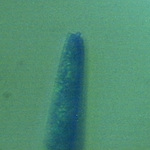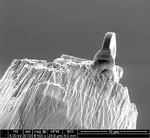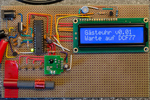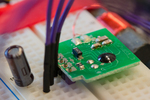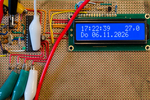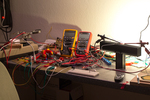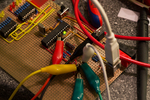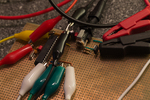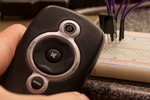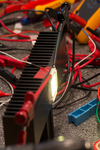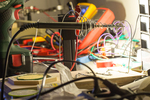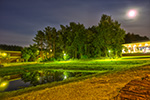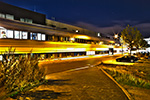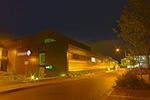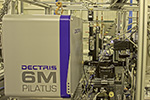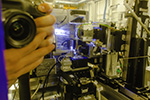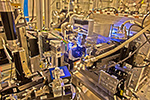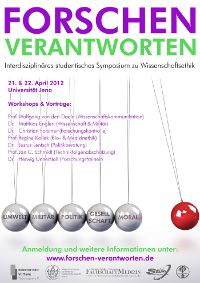Fr 16. Aug 08:13:20 CEST 2013
Welttournee
Morgen beginnt eine kleine Welttournee: Die Linse „in concert“.
Zunächst fliege ich nach New York (drei Tage Urlaub); dann geht es zum Bruchhafen Nationallabor, genauer zum im Bau befindlichen Synchrotron „NSLS-II“. Dort sind derzeit zwei ehemaliger Göttinger dabei, neue Experimente aufzubauen. Nächstes Jahr wollen wir dann dort auch messen.
Neben zahlreichen Diskussionen steht auch ein Dreiviertelstünder auf dem Programm:
Einen Samstag später fliegt es dann weiter nach San Diego. Dort öffnet die SPIE ihre Tore, um 15 Minuten lang etwas über unsere Weltrekordlinse zu erfahren:
Wiederum einen Samstag drauf: Rückflug bis Frankfurt, danach an Göttingen vorbei hoch in den Norden. In Hamburg ist die ICXOM, von unseren Freunden vom DESY und aus Dresden. Auch dort als Stargast: die Linse.
Zunächst fliege ich nach New York (drei Tage Urlaub); dann geht es zum Bruchhafen Nationallabor, genauer zum im Bau befindlichen Synchrotron „NSLS-II“. Dort sind derzeit zwei ehemaliger Göttinger dabei, neue Experimente aufzubauen. Nächstes Jahr wollen wir dann dort auch messen.
Neben zahlreichen Diskussionen steht auch ein Dreiviertelstünder auf dem Programm:
Einen Samstag später fliegt es dann weiter nach San Diego. Dort öffnet die SPIE ihre Tore, um 15 Minuten lang etwas über unsere Weltrekordlinse zu erfahren:
Wiederum einen Samstag drauf: Rückflug bis Frankfurt, danach an Göttingen vorbei hoch in den Norden. In Hamburg ist die ICXOM, von unseren Freunden vom DESY und aus Dresden. Auch dort als Stargast: die Linse.
Do 15. Aug 20:05:42 CEST 2013
Weltrekord.
So.
Unsere Linse hat den kleinsten Fokus.
Bereits im Oktober 2012 konnten wir am GINI-X-Aufbau mit einer Multilagen-Zonenplatte einen Röntgenstrahl auf unter 5 nm × 5 nm fokussieren. Das sieht dann z.B. so aus: Rechts und links im Bild zwei optische Mikroskope zur Justage. In der Mitte eine kleine Nadel. Oben drauf, hier nicht zu erkennen: Eine 2 Mikrometer kleine Linse.
Einmal durch das rechte Mikroskop geschaut lässt sich die Linse schon ein wenig erahnen. Hat man gerade ein Elektronenmikroskop zu Hand, sieht das doch schon wirklich wie eine eine Linse aus.
Unsere Linse hat den kleinsten Fokus.
Bereits im Oktober 2012 konnten wir am GINI-X-Aufbau mit einer Multilagen-Zonenplatte einen Röntgenstrahl auf unter 5 nm × 5 nm fokussieren. Das sieht dann z.B. so aus: Rechts und links im Bild zwei optische Mikroskope zur Justage. In der Mitte eine kleine Nadel. Oben drauf, hier nicht zu erkennen: Eine 2 Mikrometer kleine Linse.
Einmal durch das rechte Mikroskop geschaut lässt sich die Linse schon ein wenig erahnen. Hat man gerade ein Elektronenmikroskop zu Hand, sieht das doch schon wirklich wie eine eine Linse aus.
Sa 3. Aug 18:33:57 CEST 2013
Gästeuhr
Die Gästeuhr für das Gästebett unserer neuen Wohnung wird immer fertiger:
Das DCF77-Modul ist nun auf die Platine gelötet. Vorher sah das noch so aus:
Nachdem dann einmal das Funkuhr-Signal empfangen wurde, läuft die Uhr. Hier ist aber offensichtlich etwas schief gelaufen:
Aktuell liegen wohl noch zu viele Atmega-Eingänge in der Luft und warten auf Pull-Up-Widerstände. Das kommt dann irgendwann anders...
Geplant für die Gästeuhr ist noch ein Drehregler zum Einstellen der Weckzeit, sowie ein weiterer Drehregler um die Helligkeit der unten rechts noch nicht eingelöteten LEDs drehzureglen.
Achja, im Display oben rechts steht die Temperatur, der Sensor ist ein DS 18S20 und direkt über den Antennenklebeband zu finden. Vielleicht sollte er nicht direkt an einem Ohmschen Erhitzer liegen?
Das DCF77-Modul ist nun auf die Platine gelötet. Vorher sah das noch so aus:
Nachdem dann einmal das Funkuhr-Signal empfangen wurde, läuft die Uhr. Hier ist aber offensichtlich etwas schief gelaufen:
Aktuell liegen wohl noch zu viele Atmega-Eingänge in der Luft und warten auf Pull-Up-Widerstände. Das kommt dann irgendwann anders...
Geplant für die Gästeuhr ist noch ein Drehregler zum Einstellen der Weckzeit, sowie ein weiterer Drehregler um die Helligkeit der unten rechts noch nicht eingelöteten LEDs drehzureglen.
Achja, im Display oben rechts steht die Temperatur, der Sensor ist ein DS 18S20 und direkt über den Antennenklebeband zu finden. Vielleicht sollte er nicht direkt an einem Ohmschen Erhitzer liegen?
Do 1. Aug 09:25:38 CEST 2013
Lötprojekt: Schlafzimmerlampe
Oha, wir haben hier gar keine Kategorie „Löten“. Naja, ist es halt Physik :)
Das Projekt „Eieruhr“ ist bereits in Betrieb und wird hier beizeiten verbloggt. Die Wohnzimmerlampe muss demnächst noch einmal ein wenig aufgemotzt werden.
Heute gibt es Neuigkeiten zur Schlafzimmerlampe. Hier einmal der Testaufbau:
Schnell zu sehen: Wir haben jetzt auch ein rotes Multimeter im Einsatz. Ein unfairer Vergleich der beiden sollte vielleicht auch noch folgen.
Aber jetzt erst einmal Detailaufnahmen:
Es ist im Wesentlichen der USB-ASP-Aufbau, der Übersichtlichkeit zu Liebe mit farbigen Krokokabeln verbunden. Oben links sind noch zwei Schieberegister mit 16 LEDs zum Debuggen, wenn man sich mal ein paar Variablenwerte live anzeigen lassen möchte. Ist manchmal hilfreicher als Multimeter-Debugging.
Die Krokos kommen vom Programmierer, der Fotodiode (Gemach) oder gehen ins Multimeter. Oben leicht rechts der Mitte (die sogenannte „SPD-Position“) kommt das Netzteil rein. Daneben ist ein MOSFET zum Schalten, rechts geht es dann (farbig korrekt) zur Kraft-Leuchtdiode.
Laut und leise heißt hier natürlich hell und dunkel. Wesentliches Bauteil ist das kleine TSOP31236-Modul: dieses filtert den RC 5-Code um 36 kHz (siehe Internet für Erklärungen). Der Atmega dekodiert den Code dann und steuert per Pulsweitenmodulation (PWM) die Helligkeit der LED:
Eine 30 Watt-Hochkraftleuchtdiode vom Typ 19K30YWHA: wir emittieren warm-weiß und erhitzen den Kühlkörper. Denn auch die „energiesparenden“ LEDs wandeln noch immer einen Großteil der Energie direkt in Wärme um. Und gehen dabei kaputt.
Das Datenblatt empfiehlt, nicht deutlich über 65 Grad zu gehen. Diese sind schnell erreicht, aber unser Kühlkörper, ein V 7495E Profilkühlkörper, 250 mm lang, ist bei einem Wärmewiderstand von nur 0,9 Kelvin pro Watt nicht sonderlich beeindruckt. Mit Isolierband verbunden ist ein Temperatursensor, der nur knapp über 50 Grad misst.
Meine Frau hat mir zum Geburtstag diese Lötstation ge(bastelt|schenkt).
(Wird fortgesetzt)
Das Projekt „Eieruhr“ ist bereits in Betrieb und wird hier beizeiten verbloggt. Die Wohnzimmerlampe muss demnächst noch einmal ein wenig aufgemotzt werden.
Heute gibt es Neuigkeiten zur Schlafzimmerlampe. Hier einmal der Testaufbau:
Schnell zu sehen: Wir haben jetzt auch ein rotes Multimeter im Einsatz. Ein unfairer Vergleich der beiden sollte vielleicht auch noch folgen.
Aber jetzt erst einmal Detailaufnahmen:
Es ist im Wesentlichen der USB-ASP-Aufbau, der Übersichtlichkeit zu Liebe mit farbigen Krokokabeln verbunden. Oben links sind noch zwei Schieberegister mit 16 LEDs zum Debuggen, wenn man sich mal ein paar Variablenwerte live anzeigen lassen möchte. Ist manchmal hilfreicher als Multimeter-Debugging.
Die Krokos kommen vom Programmierer, der Fotodiode (Gemach) oder gehen ins Multimeter. Oben leicht rechts der Mitte (die sogenannte „SPD-Position“) kommt das Netzteil rein. Daneben ist ein MOSFET zum Schalten, rechts geht es dann (farbig korrekt) zur Kraft-Leuchtdiode.
Laut und leise heißt hier natürlich hell und dunkel. Wesentliches Bauteil ist das kleine TSOP31236-Modul: dieses filtert den RC 5-Code um 36 kHz (siehe Internet für Erklärungen). Der Atmega dekodiert den Code dann und steuert per Pulsweitenmodulation (PWM) die Helligkeit der LED:
Eine 30 Watt-Hochkraftleuchtdiode vom Typ 19K30YWHA: wir emittieren warm-weiß und erhitzen den Kühlkörper. Denn auch die „energiesparenden“ LEDs wandeln noch immer einen Großteil der Energie direkt in Wärme um. Und gehen dabei kaputt.
Das Datenblatt empfiehlt, nicht deutlich über 65 Grad zu gehen. Diese sind schnell erreicht, aber unser Kühlkörper, ein V 7495E Profilkühlkörper, 250 mm lang, ist bei einem Wärmewiderstand von nur 0,9 Kelvin pro Watt nicht sonderlich beeindruckt. Mit Isolierband verbunden ist ein Temperatursensor, der nur knapp über 50 Grad misst.
Meine Frau hat mir zum Geburtstag diese Lötstation ge(bastelt|schenkt).
(Wird fortgesetzt)
Di 25. Sep 22:45:46 CEST 2012
HDR at Desy
Today we see some HDR photographs of the Max von Laue-Halle, as the formerly
Gebäude 47c was baptised just recently by Mrs Merkel.
(more to come tomorrow)
(more to come tomorrow)
Mo 24. Sep 21:41:46 CEST 2012
closeup of the sample region
So 11. Mär 14:50:15 CET 2012
correlated random numbers
For the block course "Grundlagen des Experimentierens" I programmed a small CouchDB based online data acquisition and
live visualisation tool. A toy model featuring
jquery and
flot can be found
here.
On the right you enter pairs of numbers (or use the provided (pseudo) random number generator), on the left you'll get a scatter plot. The PRNG gives you 500 pairs of numbers, approximately Gaussian with a standard deviation of 15, centered at (50,50). The lineare correlation coefficient is set to -0.6, but will be adjustable soon.
On the right you enter pairs of numbers (or use the provided (pseudo) random number generator), on the left you'll get a scatter plot. The PRNG gives you 500 pairs of numbers, approximately Gaussian with a standard deviation of 15, centered at (50,50). The lineare correlation coefficient is set to -0.6, but will be adjustable soon.
Mi 7. Mär 08:24:20 CET 2012
agenda piling up
Much to do these days: next week we host the Blockkurs: Grundlagen des
Experimentierens, which is consuming about 6 hours per day of preparation. Did
not sleep well, thinking of items for the exam.
Tool using Apache Couch DB for an online correlation of students' data (e.g. weight / size) is running; my 1 bit AD converter (aka one pin of the parallel port) to query a pendulum's light sensor is also working and samples with up to 10 kBq (not kHz, since Linux's scheduler is rather sloppy on a sub-ms timescale); exercises might be ready this afternoon.
And then we have the computer crash course, with talks about on Friday and regexp already
tomorrow. Prep just tonight.
on Friday and regexp already
tomorrow. Prep just tonight.
Sorry, ML publication postponed again; but I did find some time to incorporate many of JP's remarks.
Tool using Apache Couch DB for an online correlation of students' data (e.g. weight / size) is running; my 1 bit AD converter (aka one pin of the parallel port) to query a pendulum's light sensor is also working and samples with up to 10 kBq (not kHz, since Linux's scheduler is rather sloppy on a sub-ms timescale); exercises might be ready this afternoon.
And then we have the computer crash course, with talks about
 on Friday and regexp already
tomorrow. Prep just tonight.
on Friday and regexp already
tomorrow. Prep just tonight.
Sorry, ML publication postponed again; but I did find some time to incorporate many of JP's remarks.
So 4. Mär 09:57:06 CET 2012
Forschen verantworten
In late April there's a symposium "Forschen verantworten" (maybe "account for
research") in Jena, organised by scholarship holders of the Heinrich-Böll-Stiftung.
It's about freedom of research; relations between science, politics, and people; ethics and moral, concerning impact assessment of technology. So a lot of important topics for responsible and farsighted physicists, both students and researchers.
beam me up, Scotty
It's about freedom of research; relations between science, politics, and people; ethics and moral, concerning impact assessment of technology. So a lot of important topics for responsible and farsighted physicists, both students and researchers.
beam me up, Scotty
Do 16. Feb 08:33:09 CET 2012
Go, Alex, go!
"Calorimeter-Based Triggers at the ATLAS Detector for Supersymmetry in
Zero-Lepton Final States"
today, 10 am, defense-approved SR 7
today, 10 am, defense-approved SR 7
Di 7. Feb 07:53:34 CET 2012
coding: lucky look
Some weeks ago new digital cameras for IRP's microscopes arrived. Project name of my web-based live viewer: lucky look.
List of features, those marked with an asterisk (*) are planned, those with a plus (+) are currently under development and testing:
List of features, those marked with an asterisk (*) are planned, those with a plus (+) are currently under development and testing:
- Half sized (or in 2D: quarter sized) and full size live view mode
- Collaborative markers and lines in different colours, parallel for all users
- Generate PostScript file including markers and lines, to print and paste into your lab book (different sizes)
- Live viewing everywhere, including hutch and canteen
- (+) Parallel viewing of two cameras (we have three)
- (*) Add text notes
- (*) Set exposure time and gain from your running spec session
- (*) Support of layers that can be hidden
- (*) Remove single markers
- (+) Screenshots follow shortly.
Do 19. Jan 08:19:57 CET 2012
coding: a collaborative microscope viewer
At the IRP we got
new microscope cams for our set-up at P10.
If shutter speed allows for maximum frame rate, they give you 74 MByte per
second, so two of them pose quite a challenge on our network connections.
Currently I'm working on web based live viewer using a MJPEG coder, that allows for viewing the stream from every computer on our network, not just only one (as before). Markers (crosses and lines) are drawn by Javascript in an HTML canvas; they also appear on all screens (but can soon be muted).
Currently I'm working on web based live viewer using a MJPEG coder, that allows for viewing the stream from every computer on our network, not just only one (as before). Markers (crosses and lines) are drawn by Javascript in an HTML canvas; they also appear on all screens (but can soon be muted).
So 15. Jan 15:22:46 CET 2012
abstract time
It's abstract time.
Soon there's the Users' Meeting both of European XFEL and Hasylab in Hamburg, the 3-Way-Meeting in Grenoble, and the Users' Meeting of Grenoble's ESRF. Tonight is deadline for SRI in July and Lyon. Have to finish that, too...
Soon there's the Users' Meeting both of European XFEL and Hasylab in Hamburg, the 3-Way-Meeting in Grenoble, and the Users' Meeting of Grenoble's ESRF. Tonight is deadline for SRI in July and Lyon. Have to finish that, too...
Fr 2. Dez 17:05:16 CET 2011
Disputation
Today I picked up my Grünemappe (German neologism for a briefcase of green
colour) that holds my thesis and — at the time of writing — one report.
Tomorrow morning, professor number two will carry it to professor number three
to enrich the latter's breakfast. They are neighbours, as professor number two
told me several times.
On Monday, professor number three gives it to professor number four, working the door next to him. Professor number four will write me an e-mail, and after sealing I will carry the Grünemappe over to the Institute of Computer Science, where professor number five and professor number six have their offices across the hallway.
Since our Dekanat is closed on Monday, due time of returning the Grünemappe is extended to Tuesday.
Phew!
click me and scroll to the 15th of December...
On Monday, professor number three gives it to professor number four, working the door next to him. Professor number four will write me an e-mail, and after sealing I will carry the Grünemappe over to the Institute of Computer Science, where professor number five and professor number six have their offices across the hallway.
Since our Dekanat is closed on Monday, due time of returning the Grünemappe is extended to Tuesday.
Phew!
click me and scroll to the 15th of December...



